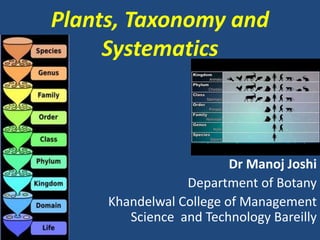
Classification seven kingdom
- 1. Plants, Taxonomy and Systematics Dr Manoj Joshi Department of Botany Khandelwal College of Management Science and Technology Bareilly
- 2. What is Taxonomy • Taxonomy (or systematics) is basically concerned with the classification of organisms. Living organisms are placed in groups on the basis of similarities and differences at the organismic, cellular, and molecular levels. • The United Nations Environment Programme’s Global Biodiversity Assessment estimates the number of described species of living organisms as approximately 1.75 million. The list grows longer every year. Classifying these organisms has been a major challenge, and the last few decades have seen a lot of realignments as additional ultrastructural and molecular information piles up.
- 3. PLANTS AND KINGDOMS OF LIFE • Plants are man’s prime companions in this universe, being the source of food and energy, shelter and clothing, drugs and beverages, oxygen and aesthetic environment, and as such they have been the dominant component of his taxonomic activity through the ages. • Before attempting to explore the diversity of plant life it is essential to understand as to what is our understanding of the term Plant, and the position of plants in the web of life. Traditionally the plants are delimited as organisms possessing cell wall, capable of photosynthesis, producing spores and having sedentary life. A lot of rethinking has resulted in several different interpretations of the term plant.
- 4. Two Kingdom System • The living organisms were originally grouped into two kingdoms. Aristotle divided all living things between plants, which generally do not move or have sensory organs, and animals. Linnaeus in his Systema naturaepublished in 1735 placed them under Animalia (Animals) and Vegetabilia (Plants) as two distinct kingdoms (Linnaeus placed minerals in the third kingdom Mineralia). • Linnaeus divided each kingdom into classes, later grouped into phyla for animals and divisions for plants. When single-celled organisms were first discovered, they were split between the two kingdoms: mobile forms in the animal phylum Protozoa, and colored algae and bacteria in the plant division Thallophyta or Protophyta. • Ernst Haeckel (1866) suggested creating a third kingdom Protista for them, although this was not very popular until relatively recently (sometimes also known as Protoctista). Haeckel recognized three kingdoms: Protista, Plantae and Animalia.
- 6. Two Empires Three Kingdoms • Led Chatton (1937) to propose a division of life into two empires: organisms with a nucleus in Eukaryota and organisms without in Prokaryota. • Chatton’s proposal, however, was not taken up immediately, because another classification was proposed by Herbert Copeland (1938), who gave the prokaryotes a separate kingdom, originally called Mycota but later referred to as Monera or Bacteria. • Copeland later on (1956) proposed a four-kingdom system placing all eukaryotes other than animals and plants in the kingdom Protoctista, thus recognizing four kingdoms Monera, Protoctista, Plantae and Animalia. The importance of grouping these kingdoms in two empires, as suggested earlier by Chatton was popularized by Stanier and van Niel (1962), and soon became widely accepted.
- 8. Five Kingdom System • American biologist Robert H. Whittaker (1969) proposed the removal of fungi into aseparate kingdom thus establishing a five kingdom system recognizing Monera, Protista, Fungi, Plantae and Animalia as distinct kingdoms. The fungi like plants have a distinct cell wall but like animals lack autotrophic mode of nutrition.
- 9. Six or Seven Kingdoms? • Subsequent research concerning the organisms previously known as archebacteria has led to the recognition that these creatures form an entirely distinct kingdom Archaea. • These include anaerobic bacteria found in harsh oxygen-free conditions and are genetically and metabolically completely different from other, oxygen- breathing organisms. • These bacteria, called Archaebacteria, or simply Archaea, are said to be “living fossils” that have survived since the planet’s very early ages, before the Earth’s atmosphere even had free oxygen. This together with the emphasis on phylogeny requiring groups to be monophyletic resulted in a six kingdom system proposed by Carl Woese et al. (1977). • They grouped Archaebacteria and Eubacteria under Prokaryotes and rest of the four kingdoms Protista, Fungi, Plantae and Animalia under Eukaryotes. They subsequently (1990) grouped these kingdoms into three domains Bacteria (containing Eubacteria), Archaea(containing Archaebacteria) and Eukarya (containing Protista, Fungi, Plantae and Animalia).
- 11. • Margulis and Schwartz (1998) proposed term superkingdom for domains and recognized two superkingdoms: Prokarya (Prokaryotae) and Eukarya (Eukaryotae). Former included single kingdom Bacteria (Monera) divided into two subkingdoms Archaea and Eubacteria. Eukarya was divided into four kingdoms: Protoctista (Protista), Animalia, Plantae and Fungi. • Several recent authors have attempted to recognize seventh kingdom of living organisms, but they differ in their treatment. Ross (2002, 2005) recognized Archaebacteria and Eubacteria as separate kingdoms, named as Protomonera and Monera, respectively again under separate superkingdoms (domains of earlier authors) Archaebacteriae and Eubacteria. He added seventh kingdom Myxomycophyta of slime moulds under superkingdom Eukaryotes. Two additional superkingdoms of extinct organisms Progenotes (first cells) and Urkaryotes (prokaryotic cells that became eukaryotes) were added: